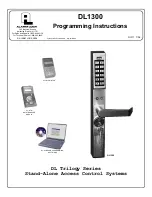
7
ory can be thought of as simply a numbered list from 1
through 2000. Each entry in the list is represented by a User
Number. Therefore,
where
a User is located in this list--their
User Location
--is a commonly used description of their User
Number. Because of their similarities, a
User Number
,
User
Location
and
Location Number
can be used interchangeably.
In some DL-Windows screens, the word "Slot" is also used.
They all mean the same thing.
Since User Numbers are fixed, knowing a User Number will
specify the associated Programming Level, and will in turn
indicate a User’s programming abilities. For example, User
Number 1 is always the Master, who can perform all program-
ming tasks.
Programming Levels are hierarchical--higher levels are al-
lowed to do anything the levels below them can do. For ex-
ample, if you are User 2, you are allowed to do anything that
Users 3 through 2000 can do.
What is a
Group
?
With many lock applications, it is convenient for large num-
bers of similar Users to be grouped together. Placing Users
into Groups (by assigning them specific User Numbers) al-
lows large numbers of Users to be controlled all at once
rather than individually--saving time and effort. Groups can
be controlled via schedules, and a typical example involves
enabling or disabling a Group at a certain time. Default
Group associations are specified in the tables on page 8. For
example, if you wish to add a User to Group 1, assign this
User a User Number between 51 and 100. These default
Group associations can be changed if needed to allow
Groups larger than the default number of 50 (by using keypad
Function 35). See page 18 for some Group function exam-
ples.
Who are
Users 297-300
?
Users assigned to User Numbers 297, 298, 299 and 300
have special abilities, as follows:
User 297:
Quick Enable User 300
User 297 possesses the unique ability to enable the User
Code associated with User 300. User 297 does this by first
entering their own
User 297 User Code
into the lock keypad.
When User 300 subsequently enters their
User 300 User
Code
, the lock allows access (for one time) and then the
User 300 User Code
becomes disabled.
For example, you wish to allow one-time access to a tempo-
rary worker. Simply enter the
User 297 User Code
into the
lock keypad. Later, when the temporary worker enters the
User 300 User Code
into the lock keypad, the
User 300
User Code
allows access (for one time only) and then be-
comes disabled. Later, if you wish to grant the temporary
worker re-access, simply re-enter the
User 297 User Code
and the
User 300 User Code
will be re-enabled (again for
one time only).
User 298:
Quick PC Access Code
Entering the User Code for User 298 enables that User to
send data to or from the lock. Therefore, User 298 can acti-
vate what is the equivalent of Function 58 in Program Mode
(see page 22), without the need to enter Program Mode nor
the need to know the Master Code of the lock. An AL-PCI
cable with a PC is required.
User 299:
AL-DTM Code
This is the only User Code that will initiate data transfer with
the AL-DTM--and without allowing unlocking the lock (the
User Code for User 299 is not an
access code
). An AL-PCI
cable and an AL-DTM (first programmed by the computer in
DL-Windows) is required.
User 300:
One-Time Only Service Code
This is a
One-Time Only Service User Code
enabled by
User 297. For example, User Code 300 is sometimes used
for guard tour duties. See
User 297: Quick Enable User
300
above.
What is
DL-Windows
?
DL-Windows is a computer program that allows you to pro-
gram your ALARM LOCK security lock. You do not need DL-
Windows to program your lock, but it makes programming
much faster and easier. With DL-Windows, you can quickly
create Lock Programs (programs that make the lock perform
its many functions) add multiple Users (who have access),
retrieve event logs, and create Schedules. The benefit of DL-
Windows is that it allows you to set up all lock programming
in advance (on your computer), and then later send the infor-
mation to the locks at your convenience.
Terminology Used in this Manual (cont'd)








































